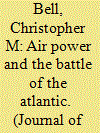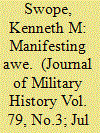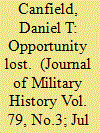|
|
|
Sort Order |
|
|
|
Items / Page
|
|
|
|
|
|
|
| Srl | Item |
| 1 |
ID:
140934


|
|
|
|
|
| Summary/Abstract |
Several nations experimented with military ballooning in the mid-nineteenth century, despite limitations such as lack of controllability. The key factor in whether or not the belligerents perceived ballooning as valuable was the type of warfare involved. When balloons were used in static warfare, such as siege conditions, their usefulness usually encouraged further experimentation. The American Civil War draws some stark contrasts between what balloons could do during static warfare, such as the siege of Island No. 10, and what they could not do in fluid combat, as in the failure at First Bull Run. Later, Brazil employed former Union aeronauts during the siege of Humaita in Paraguay, following which the French pioneered balloon “air mail” from besieged Paris during the Franco-Prussian War. Enemy efforts to defeat ballooning included Prussian invention of what may be the world’s first purpose-built anti-aircraft gun, making the point that if an enemy thinks an innovation is valuable, then it is.
|
|
|
|
|
|
|
|
|
|
|
|
|
|
|
|
| 2 |
ID:
140931


|
|
|
|
|
| Summary/Abstract |
The prioritization of strategic bombing over trade defense by the British Air Ministry, Bomber Command, and Winston Churchill did not delay the acquisition of Very Long Range aircraft to close the Atlantic “air gap” until May 1943. The Royal Air Force’s Coastal Command possessed enough aircraft to provide air cover in the mid-Atlantic sooner than it did. The Admiralty and Coastal Command were slow to identify the need for land-based air cover in the mid-Atlantic because the U-boat threat did not develop there until mid-1942, because they expected escort carriers to provide a solution, and for technical and doctrinal reasons.
|
|
|
|
|
|
|
|
|
|
|
|
|
|
|
|
| 3 |
ID:
140932


|
|
|
|
|
| Summary/Abstract |
This article examines a large body of written and oral testimonies by American servicemen who witnessed the liberation of the Buchenwald concentration camp in April 1945. During the decades since, the experience of liberation has become a central component of American public memory of World War II in Europe. As this article demonstrates, liberator testimony has shifted in important ways during the subsequent decades, both reflecting and shaping changes in American engagement with both the war and the Holocaust.
|
|
|
|
|
|
|
|
|
|
|
|
|
|
|
|
| 4 |
ID:
140929


|
|
|
|
|
| Summary/Abstract |
Thomas J. “Stonewall” Jackson, commander of the Second Corps of the Army of Northern Virginia, was wounded at the Battle of Chancellorsville, during the American Civil War. He died eight days later. The purpose of this paper is to describe the details of Jackson’s wounding and death, while attempting to identify inconsistencies in published reports of this pivotal event in the War Between the States. The care and management provided to Jackson by his surgeon, Hunter Holmes McGuire, will be reviewed and placed in context with standards of medical care of that era.
|
|
|
|
|
|
|
|
|
|
|
|
|
|
|
|
| 5 |
ID:
140933


|
|
|
|
|
| Summary/Abstract |
Against a backdrop of pressing economic and strategic concerns shaping British policies after the Second World War, Field Marshal Lord Montgomery, Chief of the Imperial General Staff, embarked on an official tour of Africa in November–December 1947. He visited South Africa, Southern Rhodesia, Kenya, Ethiopia, Sudan, and Egypt, as well as other African territories. Montgomery’s controversial report and the reactions to it cast light on British attitudes towards and perceptions of her African empire in the immediate postwar period, as shaped by Labour government defence and developmental policies. At the same time, it invites reconsideration of Montgomery’s place in imperial and military historiography.
|
|
|
|
|
|
|
|
|
|
|
|
|
|
|
|
| 6 |
ID:
140928


|
|
|
|
|
| Summary/Abstract |
This article examines recent theories concerning Chinese grand strategy and strategic culture in reference to China’s Ming Dynasty (1368–1644) and evaluates their applicability in light of the actual policy choices and military activities pursued by Ming emperors and the types of military challenges they faced. It examines the entire scope of the dynasty to discern broad patterns and points of comparison while also highlighting the crucial importance of individual imperial agency in a despotic political system. It concludes that the Ming rulers did have a very straightforward overarching grand strategy, succinctly rendered as “manifesting awe,” and that this was in line not only with Chinese dynastic precedents, but quite similar to strategies deployed by contemporary monarchies around the globe.
|
|
|
|
|
|
|
|
|
|
|
|
|
|
|
|
| 7 |
ID:
140930


|
|
|
|
|
| Summary/Abstract |
This article examines the use of combined army-navy operations and the development of Union military strategy during the first year of the war. It argues that the army and the navy, despite differences in service culture, a paucity of joint doctrine, and the absence of a “formal” general staff system were, in fact, working together to design and implement an overall strategic concept during the crucial opening months of the conflict. Despite several early examples of impressive inter-service cooperation, however, the greater use of combined army-navy operations eventually succumbed to the confluence of personality, military paradigm, and strategic choice.
|
|
|
|
|
|
|
|
|
|
|
|
|
|
|
|
|
|
|
|
|